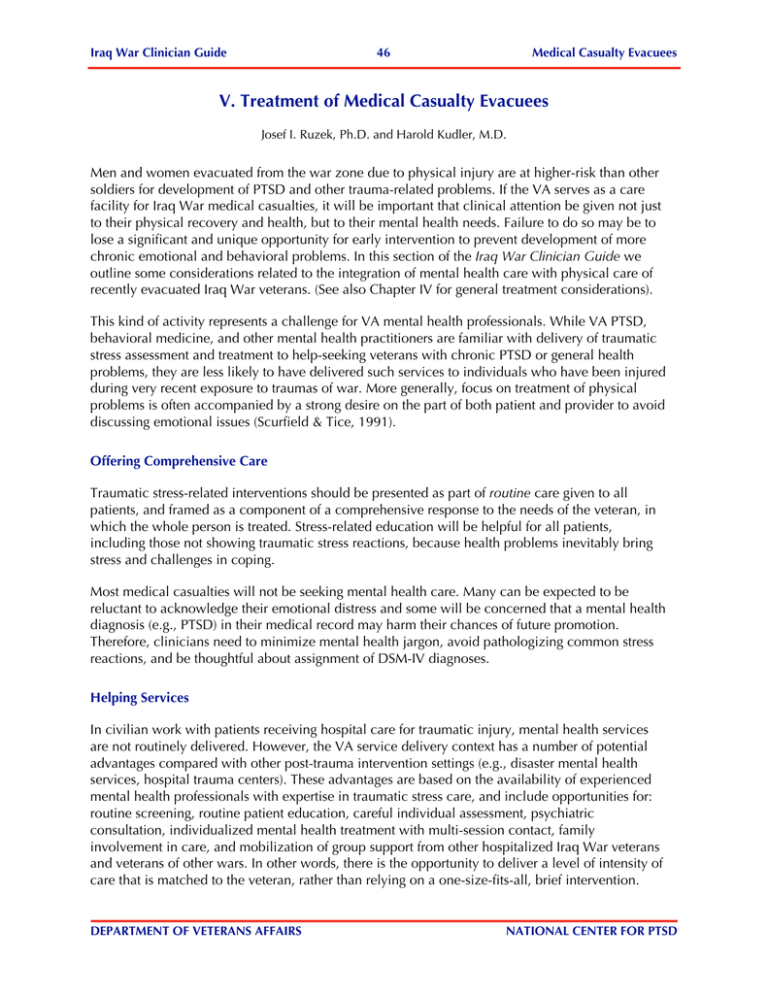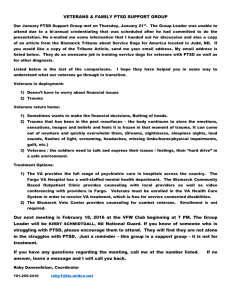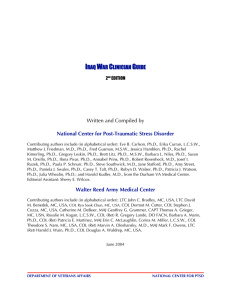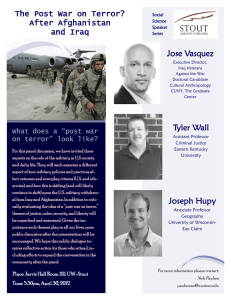V. Treatment of Medical Casualty Evacuees
advertisement

Iraq War Clinician Guide 46 Medical Casualty Evacuees V. Treatment of Medical Casualty Evacuees Josef I. Ruzek, Ph.D. and Harold Kudler, M.D. Men and women evacuated from the war zone due to physical injury are at higher-risk than other soldiers for development of PTSD and other trauma-related problems. If the VA serves as a care facility for Iraq War medical casualties, it will be important that clinical attention be given not just to their physical recovery and health, but to their mental health needs. Failure to do so may be to lose a significant and unique opportunity for early intervention to prevent development of more chronic emotional and behavioral problems. In this section of the Iraq War Clinician Guide we outline some considerations related to the integration of mental health care with physical care of recently evacuated Iraq War veterans. (See also Chapter IV for general treatment considerations). This kind of activity represents a challenge for VA mental health professionals. While VA PTSD, behavioral medicine, and other mental health practitioners are familiar with delivery of traumatic stress assessment and treatment to help-seeking veterans with chronic PTSD or general health problems, they are less likely to have delivered such services to individuals who have been injured during very recent exposure to traumas of war. More generally, focus on treatment of physical problems is often accompanied by a strong desire on the part of both patient and provider to avoid discussing emotional issues (Scurfield & Tice, 1991). Offering Comprehensive Care Traumatic stress-related interventions should be presented as part of routine care given to all patients, and framed as a component of a comprehensive response to the needs of the veteran, in which the whole person is treated. Stress-related education will be helpful for all patients, including those not showing traumatic stress reactions, because health problems inevitably bring stress and challenges in coping. Most medical casualties will not be seeking mental health care. Many can be expected to be reluctant to acknowledge their emotional distress and some will be concerned that a mental health diagnosis (e.g., PTSD) in their medical record may harm their chances of future promotion. Therefore, clinicians need to minimize mental health jargon, avoid pathologizing common stress reactions, and be thoughtful about assignment of DSM-IV diagnoses. Helping Services In civilian work with patients receiving hospital care for traumatic injury, mental health services are not routinely delivered. However, the VA service delivery context has a number of potential advantages compared with other post-trauma intervention settings (e.g., disaster mental health services, hospital trauma centers). These advantages are based on the availability of experienced mental health professionals with expertise in traumatic stress care, and include opportunities for: routine screening, routine patient education, careful individual assessment, psychiatric consultation, individualized mental health treatment with multi-session contact, family involvement in care, and mobilization of group support from other hospitalized Iraq War veterans and veterans of other wars. In other words, there is the opportunity to deliver a level of intensity of care that is matched to the veteran, rather than relying on a one-size-fits-all, brief intervention. DEPARTMENT OF VETERANS AFFAIRS NATIONAL CENTER FOR PTSD Iraq War Clinician Guide 47 Medical Casualty Evacuees Routine screening. Proactive care of returning veterans will require that they be routinely screened for post-traumatic distress and mental health problems. In the absence of direct enquiry about distress and symptoms, it is likely that many individuals with significant problems will be missed. Iraq War veterans, like other populations, cannot be expected to spontaneously disclose their distressing war experiences and associated problems. Several paper-and-pencil screens are available (see Assessment and Primary Care sections). It is important for mental health professionals to become a routine presence on medical and surgical settings. Rather than appear with a series of medical questions, it is more helpful to present as a member of the team who would like to be helpful and who has time to listen, answer questions, or help with a problem. This approach, sometimes referred to as “therapy by walking around,” is consistent with the importance of not pathologizing reactions to overwhelming stress. It fosters trust and openness and still offers opportunities, if needed, for further assessment, triage, and treatment. Routine patient education. A good way to present services is to frame them as patient education in stress management. Patient education will offer a primary means of initiating proactive mental health care. Patients may differ greatly in their receptiveness to such discussions, and staff must remain sensitive to the state of readiness of each individual patient, and vary their approach and degree of discussion accordingly. However, it is important to initiate some discussion; failure to do so may encourage emotional avoidance and miss a significant and perhaps unique opportunity to offer preventive care. Group education “classes” can be helpful in making such discussions more acceptable to patients. They also provide opportunities for more receptive patients to model open communication and disclosure of personal stress reactions, thoughts, and feelings. Assessment. Administration of screening tools and patient education activities offer chances to determine which veterans will benefit from a more detailed assessment. Suggestions for the conduct of individual assessment are outlined in the Assessment section of this Guide, and the Instrumentation section draws attention to some useful assessment tools. In assessing stressors experienced in the war zone, clinicians should also take care to actively inquire about experiences associated with medical care and evacuation. Those being evacuated are often exposed to the suffering and death of other wounded vets. Preliminary work in the civilian sector suggests that the majority of injured patients values the opportunity to undergo a comprehensive psychosocial assessment during hospitalization, despite any inconvenience or distress caused by the process (Ruzek & Zatzick, 2000). Psychiatric consultation. In addition to their role in providing the various helping services listed in this section, consultation with psychiatry is especially important given the wide range of possible patient presentations and possible usefulness of psychotropic medications. In addition to ASD/PTSD, depression, and substance abuse, a large variety of mental health disorders (including other anxiety disorders, adjustment disorders, somatoform disorders, psychosomatic disorders, conversion disorders, dissociative amnesia disorder, and dissociative identity disorder) may be associated with exposure to combat and other war zone stressors. Medications may be useful in treating traumatic stress symptoms, associated disorders, and associated problems (e.g., sleep, nightmares). Mental health staff need to partner with Med/Surg nursing staff because these are the people who will know which patients are sleeping well, crying out in their dreams, having problems before or after family meetings, etc. Chaplain service is another valuable partner as they are a regular presence on Med/Surg units and because military personnel are used to sharing stress-related issues with military chaplains. It is essential to promote a team approach in which mental health can be a full partner in the response to medical and/or surgical patients. DEPARTMENT OF VETERANS AFFAIRS NATIONAL CENTER FOR PTSD Iraq War Clinician Guide 48 Medical Casualty Evacuees Individualized treatment. The Treatment section of this Guide outlines a variety of considerations related to delivery of services. If treatments involving exploration of traumatic experiences, cognitive restructuring, or skills training are delivered, they should include multiple treatment sessions. Where patients report symptoms consistent with a diagnosis of Acute Stress Disorder or PTSD, cognitive-behavioral treatments, comprised of education, breathing training/relaxation, imaginal and in vivo exposure, and cognitive restructuring, should be considered, given the evidence for their effectiveness with other trauma populations with ASD (Bryant, Harvey, Dang, Sackville, & Basten, 1998; Bryant, Sackville, Dang, Moulds, & Guthrie, 1999) and PTSD (e.g., Rothbaum, Meadows, Resick, & Foy, 2000). Existing alcohol and drug problems should be treated, and brief preventive alcohol interventions should be routinely administered to all other veterans who consume alcohol, given the strong association between PTSD and alcohol problems (Ouimette & Brown, 2002). In the civilian sector, a brief alcohol intervention provided to heavy drinking hospital trauma center patients resulted in significant decreases in drinking levels (Gentilello et al., 1999). In addition to such treatment, mental health practitioners can help injured and ill returnees cope more effectively with some of the specific challenges associated with their medical condition. They can help patients prepare for medical procedures (e.g., surgery) that are often experienced as trauma reminders. Such help may be especially important with sexual assault survivors, because health care examinations may present powerful triggers for traumatic stress reactions. For example, Resnick, Acierno, Holmes, Kilpatrick, and Jager (1999) developed a 17-minute educational videotape to prepare sexually-assaulted women to undergo forensic rape examinations. Shown to women immediately before the exam, the video provided information about exam procedures, showed model victims calmly completing the procedures, and instructed viewers in self-directed exposure exercises, ways of reducing avoidance, and ways of improving mood and lowering anxiety. Women viewing the video had significantly lower post-exam distress ratings and anxiety symptoms than non-viewers. Mental health professionals can also teach ways of managing pain, an important goal given that post-trauma pain has sometimes been found to predict PTSD. Generally, illness and the patient role are often associated with perceptions of lack of control, and providers need to find ways to involve their patients as active participants in their medical care, by giving information about medical conditions and procedures and maximizing patient choice wherever possible. Family involvement in care. One of the primary concerns and tasks facing the veteran is reconnection with the family. This may present some challenges for those evacuated due to injury or illness. Veterans and family members alike may feel awkward and unsure of how to talk to each other about what has happened. Scurfield and Tice (1991) identified a variety of family concerns and difficulties, including that families may feel embarrassment or shame about the emotional “breakdown” of the veteran, anger at the veteran for abandoning the family or jeopardizing its financial security, or guilt about having encouraged or allowed the veteran to go to war. Some hospitalized patients may not wish to have immediate contact with their families. Whatever the situation, mental health professionals can provide a valuable service in helping prepare patients and families alike for their initial reunion, and helping them address their emerging challenges. (See Chapter IV for a more detailed discussion of family involvement in treatment). Group support. Groups are likely to be helpful for and well received by Iraq War veterans. They may create a forum in which stress reactions can be normalized, education delivered, support given and received, and skills practiced. Groups can be expected to foster a sense of belonging to DEPARTMENT OF VETERANS AFFAIRS NATIONAL CENTER FOR PTSD Iraq War Clinician Guide 49 Medical Casualty Evacuees counter the feelings of loneliness and isolation so often experienced by returning veterans (Wain & Jaccard, 1996). Providers may wish to consider integrating Iraq War soldiers into existing specialized PTSD group services, to help the younger veterans connect with veterans of other conflicts, and to provide them with a valuable perspective on their problems. Support for health care providers. In addition to consulting with the medical care team and providing direct education, assessment, treatment, and group therapy services, mental health workers can offer a valuable service in training, and providing structured emotional support for health care workers serving casualties. Experience in military medical programs and in postdisaster situations such as the aftermath of the attacks of September 11th clearly point to the importance of taking good care of your staff. This is primarily accomplished by making sure that they take good care of themselves. Extended tours of duty are common in emergency situations but individual staff can only function under such conditions for so long. It is important to cultivate a professional culture in which people take regular breaks, get reasonable sleep and food, and have regular contact with their own colleagues, friends and family in order to support their continued work with casualties and their families. References Bryant, R.A., Harvey, A.G., Dang, S.T., Sackville, T., & Basten, C. (1998). Treatment of acute stress disorder: A comparison of cognitive-behavioral therapy and supportive counseling. Journal of Consulting and Clinical Psychology, 66, 862-866. Bryant, R.A., Sackville, T., Dang, S.T., Moulds, M., & Guthrie, R. (1999). Treating acute stress disorder: An evaluation of cognitive behavior therapy and supportive counseling techniques. American Journal of Psychiatry, 156, 1780-1786. Gentilello, L.M., Rivara, F.P., Donovan, D.M., Jurkovich, G.J., Daranciang, E., Dunn, C. W., et al. (1999). Alcohol interventions in a trauma center as a means of reducing the risk of injury recurrence. Annals of Surgery, 230, 473-483. Resnick, H., Acierno, R., Holmes, M., Kilpatrick, D.G., & Jager, N. (1999). Prevention of post-rape psychopathology: Preliminary findings of a controlled acute rape treatment study. Journal of Anxiety Disorders, 13, 359-370. Rothbaum, B.O., Meadows, E.A., Resick, P., & Foy, D.W. (2000). Cognitive-behavioral therapy. In E.B. Foa, T.M. Keane, & M.J. Friedman (Eds.), Effective treatments for PTSD: Practice guidelines from the International Society for Traumatic Stress Studies (pp. 60–83). New York: Guilford. Ruzek, J.I. & Zatzick, D.F. (2000). Ethical considerations in research participation among acutely injured trauma survivors: An empirical investigation. General Hospital Psychiatry, 22, 27-36. Ruzek, J.I. (2002). Concurrent posttraumatic stress disorder and substance use disorder among veterans: Evidence and treatment issues. In P. Ouimette & P.J. Brown (Eds.), Trauma and substance abuse: Causes, consequences, and treatment of comorbid disorders (pp. 191-207). Washington, DC: American Psychological Association. Scurfield, R.M., & Tice, S. (1991). Acute psycho-social intervention strategies with medical and psychiatric evacuees of “Operation Desert Storm” and their families. Operation Desert Storm Clinician Packet. White River Junction, VT: National Center for PTSD. Wain, H.J., & Jaccard, J.T. (1996). Psychiatric intervention with medical and surgical patients of war. In R.J. Ursano & A.E. Norwood (Eds.), Emotional aftermath of the Persian Gulf War: Veterans, families, communities, and nations (pp. 415-442). Washington, DC: American Psychiatric Press. DEPARTMENT OF VETERANS AFFAIRS NATIONAL CENTER FOR PTSD






